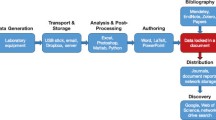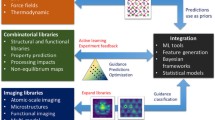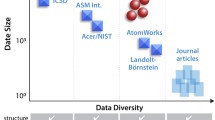Abstract
The materials innovation infrastructure in the materials genome initiative (MGI) consists of three major components: computational tools, experimental tools, and digital data. This article will review experimental tools for high-throughput, high spatial resolution measurements of several materials properties such as elastic modulus, thermal conductivity, specific heat capacity, and thermal expansion. Application of these tools on composition-varying samples such as diffusion multiples can be used to quickly and efficiently obtain composition–phase–structure–property relationships for materials property database establishment. They can also be used in conjunction with theoretical modeling to find and explain unusual effects to improve the predictability of models. More micron scale resolution experimental tools are in development. These high-throughput tools will be an essential part of MGI.









Similar content being viewed by others
References
Collins FS, Morgan M, Patrinos A (2003) The human genome project: lessons from large-scale biology. Science 300:286–290
Zhao JC (2001) A combinatorial approach for structural material. Adv Eng Mater 3:143–147
Zhao JC (2001) A combinatorial approach for efficient mapping of phase diagrams and properties. J Mater Res 16:1565–1578
Zhao JC (2005) The diffusion-multiple approach to designing alloys. Annu Rev Mater Sci 35:51–73
Zhao JC, Jackson MR, Peluso LA et al (2002) A diffusion-multiple approach for mapping phase diagrams, hardness, and elastic modulus. JOM 54:42–45
Cahill DG (2004) Analysis of heat flow in layered structures for time-domain thermoreflectance. Rev Sci Instrum 75:5119–5123
Huxtable S, Cahill DG, Fauconnier V et al (2004) Thermal conductivity imaging at micrometer-scale resolution for combinatorial studies of materials. Nat Mater 3:298–301
Zheng X, Cahill DG, Zhao JC (2005) Thermal conductivity imaging of thermal barrier coatings. Adv Eng Mater 7:622–626
Zheng X, Cahill DG, Weaver R et al (2008) Micron-scale measurements of the coefficient of thermal expansion by time-domain probe beam deflection. J Appl Phys 104:073509
Wei C, Zheng X, Cahill DG et al (2013) Invited article: Micron resolution spatially-resolved measurement of heat capacity using dual-frequency time-domain thermoreflectance. Rev Sci Instrum 84:071301
Xiang XD, Sun X, Briceño G et al (1995) A combinatorial approach to materials discovery. Science 268:1738–1740
Kaufman L, Bernstein H (1970) Computer calculation of phase diagrams with special reference to refractory metals. Pergamon Press, Oxford
Saunders N, Miodownik AP (1998) CALPHAD: a comprehensive guide. Pergamon/Elsevier, Oxford
Lukas HL, Fries SG, Sundman B (2007) Computational thermodynamics: the CALPHAD method. Cambridge University Press, Cambridge
Kattner UR (1997) The thermodynamic modeling of multicomponent phase equilibria. JOM 49:14–19
Zhao JC, Zheng X, Cahill DG (2011) High-throughput measurements of materials properties. JOM 63:40–44
Oikawa K, Qin GW, Ikeshoji T et al (2002) Direct evidence of magnetically induced phase separation in the fcc phase and thermodynamic calculations of phase equilibria of the Co–Cr system. Acta Mater 50:2223–2232
Zhao JC (2004) Reliability of the diffusion-multiple approach for phase diagram mapping. J Mater Sci 12:3913–3925
Shao G, Tsakiropoulos P (1999) Solidification structures of Ti–Al–Cr alloys. Intermetallics 7:579–587
Jin Z (1981) A study of the range of stability of sigma phase in some ternary systems. Scand J Metall 10:279–287
Zhang Q, Zhao JC (2013) Extracting interdiffusion coefficients from binary diffusion couples using traditional methods and a forward-simulation method. Intermetallics 34:132
Zhao JC, Zheng X, Cahill DG (2012) Thermal conductivity mapping of the Ni–Al system and the beta-NiAl phase in the Ni–Al–Cr system. Script Mater 66:935–938
Terada Y, Ohkubo K, Mohri T et al (1997) Thermal conductivity in nickel solid solutions. J Appl Phys 81:2263–2268
Terada Y, Ohkubo K, Mohri T et al (2000) A comparative study of thermal conductivity in alloys and compounds. Mater Sci Eng A 278:292–294
Zhao JC (2006) Combinatorial approaches as effective tools in the study of phase diagrams and composition-structure-property relationships. Prog Mater Sci 51:557–631
Cahill DG, Zheng X, Zhao JC (2010) Spatially resolved measurements of thermal stresses by picosecond time-domain probe beam deflection. J Therm Stresses 33:9–14
Guillaume CE (1920) The anomaly of the nickel-steels. Proc Phys Soc London 32:374–404
Zheng X, Cahill DG, Zhao JC (2010) Effect of MeV ion irradiation on the coefficient of thermal expansion of Fe–Ni Invar alloys: a combinatorial study. Acta Mater 58:1236–1241
Oliver WC, Pharr GM (1992) An improved technique for determining hardness and elastic modulus using load and displacing sensing indentation experiments. J Mater Res 7:1564–1583
Doerner MF, Nix WD (1986) A method for interpreting the data from depth-sensing indentation instruments. J Mater Res 1:601–609
Lee T, Ohmori K, Shin CS et al (2005) Elastic constants of single-crystal TiNx (001) (0.67 ≤ x ≤ 1.0) determined as a function of x by picosecond ultrasonic measurements. Phys Rev B B71:144106
Schmidt AJ, Cheaito R, Chiesa M (2009) A frequency-domain thermoreflectance method for the characterization of thermal properties. Rev Sci Instrum 80:094901
Takeuchi I, Yang W, Chang KS et al (2003) Monolithic multichannel ultraviolet detector arrays and continuous phase evolution in Mg x Zn1−x O composition spreads. J Appl Phys 94:7336–7340
Fukumura T, Ohtani M, Kawasaki M et al (2000) Rapid construction of a phase diagram of doped Mott insulators with a composition-spread approach. Appl Phys Lett 77:3426–3428
Wei T, Xiang XD, Wallace-Freedman WG et al (1996) Scanning tip microwave near-field microscope. Appl Phys Lett 68:3506–3508
Gao C, Wei T, Duewer F et al (1997) High spatial resolution quantitative microwave impedance microscopy by a scanning tip microwave near-field microscope. Appl Phys Lett 71:1872–1874
Boggild P, Grey F, Hassenkam T et al (2000) Direct measurement of the microscale conjugated polymer monolayers. Adv Mater 12:947–949
Chung SY, Chiang YM (2003) Microscale measurements of the electrical conductivity of doped LiFePO4. Electrochem Solid State Lett 6:A278–A281
Uchic MD, Dimiduk DM, Florando JN et al (2004) Sample dimensions influence strength and crystal plasticity. Science 305:986–989
Uchic MD, Dimiduk DM (2005) A methodology to investigate size scale effects in crystalline plasticity using uniaxial compression testing. Mater Sci Eng A 400–401:268–278
DeHoff RT (1983) Quantitative serial sectioning analysis: preview. J Microsc 131:259–263
Uchic MD, Groeber MA, Dimiduk DM et al (2006) 3D microstructural characterization of nickel superalloys via serial-sectioning using a dual beam FIB–SEM. Scripta Mater 55:23–28
Echlin MP, Mottura A, Torbet CJ et al (2012) A new TriBeam system for three-dimensional multimodal materials analysis. Rev Sci Instrum 83:023701
Dingley DJ, Randle V (1992) Microtexture determination by electron back-scatter diffraction. J Mater Sci 27:4545–4566
Schwartz AJ, Kumar M, Adams BL et al (2000) Electron Backscatter Diffraction in Materials Science. Kluwer Academic/Plenum, New York
Miao J, Pollock TM, Jones JW (2012) Microstructural extremes and the transition from fatigue crack initiation to small crack growth in a polycrystalline nickel-base superalloy. Acta Mater 60:2840–2854
Zurob HS, Hutchinson CR, Brechet Y et al (2009) Kinetic transitions during non-partitioned ferrite growth in Fe–C–X alloys. Acta Mater 57:2781–2792
Hutchinson CR, Fuchsmann A, Zurob HS et al (2004) A novel experimental approach to identifying kinetic transitions in solid state phase transformations. Scripta Mater 50:285–289
Jandeleit B, Schaefer DJ, Powers TS et al (1999) Combinatorial materials science and catalysis. Angew Chem Int Ed 38:2494–2532
Fukumura T, Yamada Y, Toyosaki H et al (2004) Exploration of oxide-based diluted magnetic semiconductors toward transparent spintronics. Appl Surf Sci 223:62–67
Koinuma H, Takeuchi I (2004) Combinatorial solid-state chemistry of inorganic materials. Nat Mater 3:429–438
Maier WF, Stowe K, Sieg S (2007) Combinatorial and high-throughput materials science. Angew Chem Int Ed 46:6016–6067
Xiang XD (1999) Combinatorial materials synthesis and screening: an integrated materials chip approach to discovery and optimization of functional materials. Annu Rev Mater Sci 29:149–171
Potyrailo RA, Mirsky VM (2008) Combinatorial and high-throughput development of sensing materials: the first 10 years. Chem Rev 108:770–813
Amis EJ, Xiang XD, Zhao JC (2002) Combinatorial materials science: what’s new since Edison. MRS Bull 27:295–300
National Research Council (2011) Application of light weighting technology in military aircraft, vessels and vehicles. The National Academies Press, Washington, pp 118–119
Robertson IM, Schuh CA, Vetrano JS et al (2011) Towards an integrated materials characterization toolbox. J Mater Res 26:1341–1383
Acknowledgments
This work was mostly supported by National Science Foundation (NSF-DMR 0804833). The author is thankful for his collaborators for their contributions, especially to David Cahill, Melvin Jackson, and Xuan Zheng.
Author information
Authors and Affiliations
Corresponding author
Additional information
SPECIAL ISSUE: Materials Genome
About this article
Cite this article
Zhao, JC. High-throughput experimental tools for the materials genome initiative. Chin. Sci. Bull. 59, 1652–1661 (2014). https://doi.org/10.1007/s11434-014-0120-1
Received:
Accepted:
Published:
Issue Date:
DOI: https://doi.org/10.1007/s11434-014-0120-1




